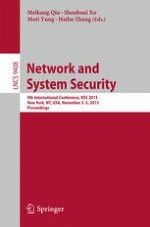This book constitutes the proceedings of the 9th International Conference on Network and System Security, NSS 2015, held in New York City, NY, USA, in November 2015.
The 23 full papers and 18 short papers presented were carefully reviewed and selected from 110 submissions. The papers are organized in topical sections on wireless security and privacy; smartphone security; systems security; applications security; security management; applied cryptography; cryptosystems; cryptographic mechanisms; security mechanisms; mobile and cloud security; applications and network security.
